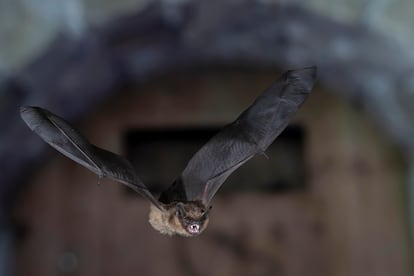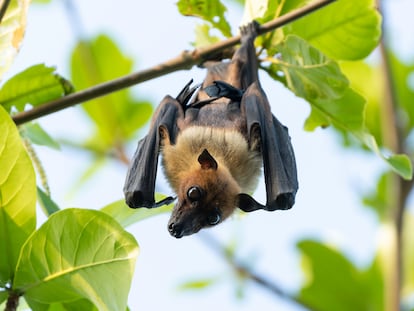The serotine bat is the first mammal known to copulate without penetration
A study has found that males of this species have a penis seven times longer than females’ vaginas, which they use to reach the vulva and mate by contact

Bats are well known for their peculiarities. Between flight and echolocation, the scientific community has been busy unraveling the nature of these behaviors. However, other aspects of their private lives, such as mating, have been less researched. Now, a study published in Current Biology has shed light on another unique feature for a mammal: the bat’s very long and wide penis, the function of which is not penetration.
Nicolas Fasel is an honorary professor at the University of Lausanne’s School of Biology and Medicine in Switzerland. By chance, he observed that male serotine bats (Eptesicus serotinus) had an erect penis seven times longer and wider than the females’ vaginas. Since then, he had been wondering how it was possible for male bats to reproduce with females. Penetration did not seem feasible, but he could not be sure.
One day, he received an email from a Dutch bat enthusiast named Jan Jeuker, who had recorded these animals having sex inside an old church. Between his videos and others taken at a bat rehabilitation center in Ukraine, researchers collected and analyzed 97 sexual encounters.

Indeed, the researchers found that penetration did not occur. The male grasps the female in a dorsoventral position, biting her on the nape of the neck. Between the hind legs and tail, females have a membrane, called the uropatagium, with which they could prevent copulation, but the male uses his long penis as an arm to push this membrane aside and make contact with the vulva.
Once the male bats manage to move the uropatagium out of the way, they must locate the vulva. There are hairs at the tip of the penis that, according to the authors of the study, could serve as a sensor that helps the bat find it. In turn, they have a hollow structure on the dorsal side of the erect penis that could act as a suction cup to maintain contact for a long time. These are not fleeting encounters; half of the recorded copulations lasted for less than 53 minutes, but the longest lasted for over 12 hours.
After mating, the female shows wet abdominal fur, suggesting that ejaculation has occurred. However, the authors acknowledge that they have not yet been able to demonstrate that sperm transfer occurs or how it happens. This could be a future avenue of research.
As Susanne Holtze, a co-author of the study and the senior scientist at the Leibniz Institute for Zoo and Wildlife Research in Berlin, Germany, explains to CNN, “How their semen actually gets into the female reproductive tract is an open question. It may be that there is some kind of suction involved. We can’t fully answer what this mechanism consists of.”
The serotine bat’s form of copulation is reminiscent of that of birds and is known as cloacal kissing, in which both sexes press their cloacae together to transfer the sperm. Among mammals, this type of copulation is rare: this is the first documented case of mammals mating without penetration. The study’s authors suspect that this must occur in only a few other bat species.
Holtze, who specializes in assisted animal reproduction, believes this discovery may help to successfully inseminate bats. “There are over 1,000 species of bats and many of them are also endangered,” she explains. “So far, an adequate strategy for assisted reproduction has not been established.”
These male serotine bats are not the only chiroptera with peculiar genitals. We have known since 1859 that the females of many bat species can store sperm. This is because the cervix, which connects the uterus to the vagina, is particularly long. In temperate climates, bat copulation usually occurs in August and September, but females do not ovulate until after hibernation, in April and May. Thus, they are able to store sperm for seven months.
Bats also engage in fellatio
This isn’t the first time that we have been surprised by the sexual habits of bats. In 2009, the journal PLoS One published a study documenting for the first time that fruit bats (Cynopterus sphinx) practice oral sex. Until then, there had been hardly any recorded cases of non-human animals performing fellatio. Sexual play between juvenile bonobos (Pan paniscus) was the only exception.
The authors of this study observed that females were not passive during copulation but instead regularly licked their partner’s penis. As the researchers explain, this behavior could have adaptive benefits: “For every second that females licked the male’s penis, copulation was prolonged by approximately six seconds. It is possible that this is because fellatio lubricates the penis and increases stimulation,” the researchers speculate. They add: “In turn, prolonged copulation could facilitate the transport of sperm from the vagina to the oviduct, or stimulate secretions from the female’s pituitary gland, thereby increasing the likelihood of fertilization. It could also be that the female’s saliva has bactericidal properties and thus helps in the prevention of sexually transmitted diseases.”
It is likely that we will learn more peculiarities about bats’ sex lives in the coming years, since it is an underexplored field that is beginning to generate more interest. Fasel’s team is already investigating penis morphology and copulation in other bat species. “We are trying to develop a ‘porn booth’ for bats, which will be like an aquarium with cameras everywhere,” the professor joked to the Spanish scientific media outlet, SINC.
Sign up for our weekly newsletter to get more English-language news coverage from EL PAÍS USA Edition
Tu suscripción se está usando en otro dispositivo
¿Quieres añadir otro usuario a tu suscripción?
Si continúas leyendo en este dispositivo, no se podrá leer en el otro.
FlechaTu suscripción se está usando en otro dispositivo y solo puedes acceder a EL PAÍS desde un dispositivo a la vez.
Si quieres compartir tu cuenta, cambia tu suscripción a la modalidad Premium, así podrás añadir otro usuario. Cada uno accederá con su propia cuenta de email, lo que os permitirá personalizar vuestra experiencia en EL PAÍS.
¿Tienes una suscripción de empresa? Accede aquí para contratar más cuentas.
En el caso de no saber quién está usando tu cuenta, te recomendamos cambiar tu contraseña aquí.
Si decides continuar compartiendo tu cuenta, este mensaje se mostrará en tu dispositivo y en el de la otra persona que está usando tu cuenta de forma indefinida, afectando a tu experiencia de lectura. Puedes consultar aquí los términos y condiciones de la suscripción digital.
More information
Últimas noticias
James Cameron: ‘For the films I like to make to continue to exist, we have to find a way to make them cheaper’
Families demand repatriation of bodies of Colombians who died in Ukraine: ‘This war is a slaughterhouse for foreigners’
The guardians of the meteorites of the Argentine Chaco
Helen Levitt, the photographer who captured the theater of the everyday
Most viewed
- Christian Louboutin: ‘Young people don’t want to be like their parents. And if their parents wear sneakers, they’re going to look for something else’
- US sanctions against jailed cartel leader ‘El Marro’ highlight Mexico’s lack of control over its prisons
- Cartels in Mexico take a leap forward with narco-drones: ‘It is criminal groups that are leading the innovation race’
- Liset Menéndez de la Prida, neuroscientist: ‘It’s not normal to constantly seek pleasure; it’s important to be bored, to be calm’
- ‘El Limones’ and the growing union disguise of Mexican organized crime











































